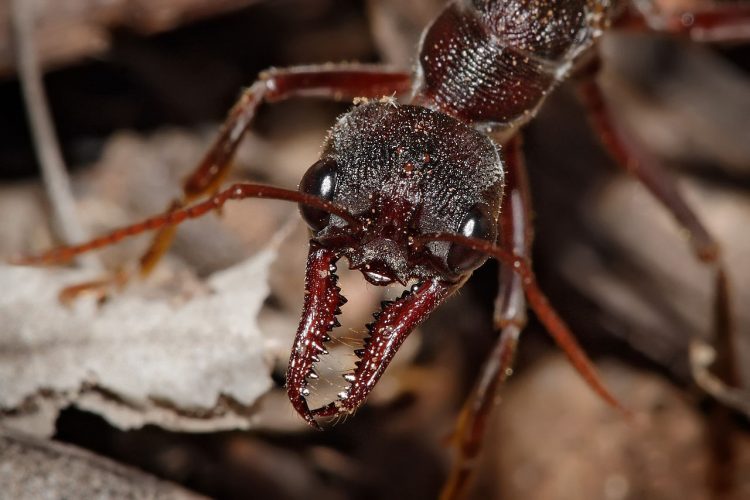Are Ants the Answer to CO2 Sequestration?

Bullant head detail
This study reveals that ants are one of the most powerful biological agents of mineral decay yet observed. It may be that an understanding of the geobiology of ant-mineral interactions might offer a line of research on how to “geoengineer” accelerated CO2 consumption by Ca-Mg silicates.
Researcher Ronald Dorn of Arizona State University writes that over geological timescales, the dissolution of calcium (Ca) and magnesium (Mg) bearing silicates has led to the graduate drawdown of atmospheric carbon dioxide (CO2) through the accumulation of limestone and dolomite. Many contemporary efforts to sequester CO2 involve burial, with some negative environmental consequences.
Dorn suggests that, given that ant nests as a whole enhance abiotic rates of Ca-Mg dissolution by two orders of magnitude (via biologically enhanced weathering), future research leading to the isolation of ant-based enhancement process could lead to further acceleration.
If ant-based enhancement could reach 100 times or greater, he writes, this process might be able to geo-engineer sequestration of CO2 from the atmosphere. Similarly, ants might also provide clues on geoengineering efficient pathways of calcium carbonate precipitation to sequester atmospheric CO2.
Earth's climate has cooled significantly over the past 65 m.y., likely from hydrologic regulation, vegetation change, and interactions related to tectonism, in part mediated by Ca-Mg silicate mineral dissolution that draws down CO2.
Although speculative, says Dorn, the timing of the expansion in the variety and number of ants in the Paleogene and the Neogene suggests that biologically enhanced weathering by ants could potentially be a part of the puzzle of Cenozoic cooling.
**FEATURED ARTICLE**
Ants as a powerful biotic agent of olivine and plagioclase dissolution
Ronald I. Dorn, School of Geographical Sciences and Urban Planning, Arizona State University, Tempe, Arizona 85287-5302, USA. Published online 14 July 2014; http://dx.doi.org/10.1130/G35825.1.
16 July 2014
GSA Release No. 14-47
Contact:
Kea Giles
Managing Editor,
GSA Communications
+1-303-357-1057
kgiles@geosociety.org
Media Contact
All latest news from the category: Life Sciences and Chemistry
Articles and reports from the Life Sciences and chemistry area deal with applied and basic research into modern biology, chemistry and human medicine.
Valuable information can be found on a range of life sciences fields including bacteriology, biochemistry, bionics, bioinformatics, biophysics, biotechnology, genetics, geobotany, human biology, marine biology, microbiology, molecular biology, cellular biology, zoology, bioinorganic chemistry, microchemistry and environmental chemistry.
Newest articles

A universal framework for spatial biology
SpatialData is a freely accessible tool to unify and integrate data from different omics technologies accounting for spatial information, which can provide holistic insights into health and disease. Biological processes…

How complex biological processes arise
A $20 million grant from the U.S. National Science Foundation (NSF) will support the establishment and operation of the National Synthesis Center for Emergence in the Molecular and Cellular Sciences (NCEMS) at…

Airborne single-photon lidar system achieves high-resolution 3D imaging
Compact, low-power system opens doors for photon-efficient drone and satellite-based environmental monitoring and mapping. Researchers have developed a compact and lightweight single-photon airborne lidar system that can acquire high-resolution 3D…





















